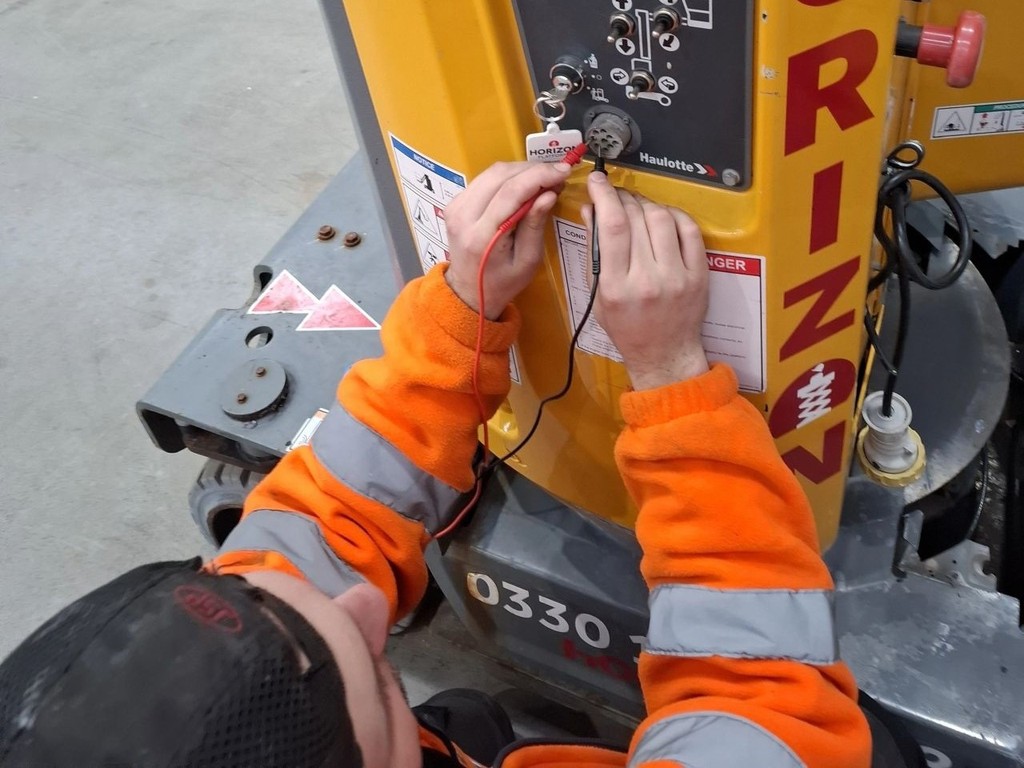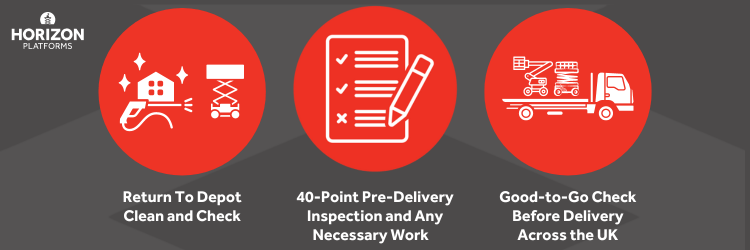Mobile Elevated Work Platform (MEWP) inspections are key for access platform safety, helping you ensure your workers won’t be boarding a faulty or dangerous work-at-height machine. However, inspecting your MEWP is pointless if you’re unsure what to look at or how often full inspections need to take place, and who can inspect what and to what level.
In this guide, we’ll offer key MEWP inspection tips for scissor lifts and cherry pickers, as well as cover the rules and regulations. All this is important for helping you and your team to carry out your work at height as safely and securely as possible.
What are MEWP Inspections?
A MEWP inspection is a series of visual and functional checks that can be carried out to ensure the MEWP is safe for use. It is Horizon’s recommendation to do a pre-use check at the beginning of each working day.
The criteria for these inspections is set by IPAF (International Powered Access Federation) and all standards need to be met for a powered access platform to be declared usable.
Regularly carrying out these checks on your access platform will help you avoid risk when working at height, as hazards can be identified before use. We advise these checks are done before each use.
For example, if your powered access platform is being used regularly in busy factories and warehouses, it may require frequent cleaning, not only for hygiene or contamination purposes but also to ensure that the safety stickers and decals on the powered access platform are visible as this is a LOLER requirement.
What are the Lifting Operations and Lifting Equipment Regulations (LOLER)?
Speaking of MEWP inspection requirements; LOLER is a collection of regulations that anyone in the UK who controls the operation of lifting equipment must follow.
The regulations regarding MEWP inspection include:
- Thorough examination every six months for powered access.
- Thorough examination when installed, re-installed and assembled at a new site.
- Thorough examination whenever the equipment has been exposed to deteriorating conditions.
Regarding point 1 above, which is referred to as the LOLER Inspection, once a machine has passed and received a certificate, people will often say a lifter has been ‘LOLERED’ or it ‘has its LOLER’.
It is important to note that LOLER inspections are a legal requirement and only people with the appropriate practical and theoretical knowledge can carry out the inspections.
What are Provision and Use of Work Equipment regulations (PUWER)?
PUWER are the regulations that must be followed by people and companies owning and operating work equipment. These require you to:
- Ensure that equipment is suitable for the task at hand.
- Equipment is used in accordance with specific requirements.
- Equipment is safe for work.
- Users have adequate information and training.
- Suitable health and safety measures are taken.
Why Are MEWP Inspections Important?
Although reputable access hire companies will supply machines with LOLERs, and companies like Horizon do pre-delivery inspections before each delivery, accidents, dangers and faults can occur unexpectedly. Therefore, a daily MEWP pre-use inspection is absolutely vital. It also:
- Protects you and your company legally: Proving that you have fully complied with health and safety regulations, by regularly and thoroughly inspecting your powered access platform, helps to demonstrate you are working to try to prevent issues, risks or injury.
- Allows you to address damages or issues swiftly: The safety benefits here are obvious, but conducting regular MEWP safety checks can also increase the lifespan of your equipment. This saves you costs in the long-run, as well as minimising downtime from significant repairs (keeping your projects on schedule).
MEWP Inspection Checklist
Whether you hire or own machinery, before use, check your MEWP and declare it safe for use. It’s important that the MEWP is checked daily before use, to ensure the machines are in working order and safe to use; this helps to avoid unnecessary risks by spotting potential issues.
MEWP Inspection Requirements
There is a specific MEWP inspection checklist which outlines exactly which parts of your machinery should be checked, and how to evaluate them. It also states that all checks must be made in accordance with the manufacturer’s manual, which leads us nicely to the first step of the inspection process.
- The inspection must begin by examining the correct documentation, which includes the manufacturer’s operator manual and rescue plan.
- The next step is to check the body of the MEWP, identifying any fuel leaks, checking hydraulic fluid levels and evaluating the condition of the MEWP’s chassis. There is also a need for a battery check on battery powered MEWPs (electrolyte, security & charging plug condition).
- Once the visual checks have been carried out on the MEWP, the function inspection must take place to ensure it’s able to be operated safely and freely. These checks ensure that all controls, lights and alarms are working properly.
- Once the inspection has been completed and the MEWP is declared safe for use, a fully IPAF trained operator can use the powered access platform.
To learn more about IPAF training, visit our guide: What Is IPAF Training & Why Is It Important?
How Often Should MEWPs be Inspected?
According to guidance from HSE regarding MEWP inspection frequency, full inspections should occur every six months by a competent person, along with daily checks.
What Daily MEWP Inspection Checks Should You Undertake?
It’s important you carry out the necessary MEWP safety checks on a regular basis, so that all on-site powered access platforms are functional and all features are working properly – this includes operating buttons, hydraulic lifts and emergency stop controls.
The full checklist for any MEWP’s daily inspection will be outlined in the machine’s operating manual. Within the operating manual, you will also be able to find a daily pre-use MEWP inspection checklist, which must be completed and recorded at the beginning of each working day by the operator to ensure the machine remains fully functional and safe.
The checklist provides proof the checks have been completed, which is important for supervisors undertaking MEWP safety checks throughout the day. If you don’t have access to the operating manual, though, for a full pre-inspection checklist that helps you declare your powered access platform fit for use, see our handy list below:
Who Is Responsible For Inspecting a MEWP?
As the operator of the MEWP, it is your legal responsibility, as part of the Provision and Use of Work Equipment Regulations (PUWER) (1998), to ensure that the powered access platforms you’re using are in good working order, maintained, and repaired before use.
Inspecting The Work Environment
As well as regular MEWP safety checks, it’s important to also ensure that the ground you will be working on is sturdy enough to support the heavy machinery.
Without carrying out an assessment of the ground, you could unknowingly be working on uneven ground or above a hollow area beneath the surface. It’s also possible for unsettled ground, such as soil, to shift when it’s tasked with supporting a heavy load, which can overturn a MEWP.
When carrying out a ground inspection, you should look out for the following hazards:
- Filled Land – Loose soil and compacted ground which can give way under the weight of the MEWP.
- Ground Excavations – Open trenches which can collapse and shift the ground from underneath the MEWP.
- Raised Floors & Basements – Any floors above ground level or basements which may not have the structural strength to support the weight of a MEWP.
- Paving Stones – Paving can be laid on weaker ground, which can support the weight of a person, but not heavy machinery such as an access platform.
- Unstable Roads – Damage and distress to roads can be a weakness when under pressure from the weight of a MEWP, and could cause the ground to give way.
- Hollow Ground – Sewers, drains and manholes can give way and collapse under the weight of a MEWP.
Once you have properly assessed the ground, you should select a MEWP which is most suitable for use on that specific terrain.
However, if the ground is unable to support the weight of the MEWP, you should avoid operating any powered access platform on this ground, as this would be extremely unsafe. Our guide to ground assessments can advise you further.
Pre-delivery MEWP Inspection Guaranteed by Horizon Platforms
Before delivering your MEWP to you, we’ll conduct a thorough pre-delivery inspection to ensure it’s in good working order.
The inspection ensures that any issues with the machine are detected and remedied before delivery, and makes sure health and safety requirements are met. Our pre-delivery inspection includes three vital steps.
- The first is a check when the MEWP arrives back at the depot to ensure it is in good condition.
- The next step is a thorough pre-delivery inspection, which must meet PUWER and LOLER standards. Any issues such as replacement of parts, repairs or repainting will then occur.
- The third step is one final good-to-go check, to ensure that nothing has been missed and to make sure customers only ever receive a MEWP in working condition.
This ensures the powered access platforms we send out for delivery are safe and in good working order, so you can enjoy complete peace of mind when hiring a MEWP from us.
We also offer IPAF training, which educates employees on the safe use and operation of MEWPs. This training is essential before attempting to use a powered access platform.
To learn more about the training we offer, including pre-delivery inspection training, please don’t hesitate to contact us.


